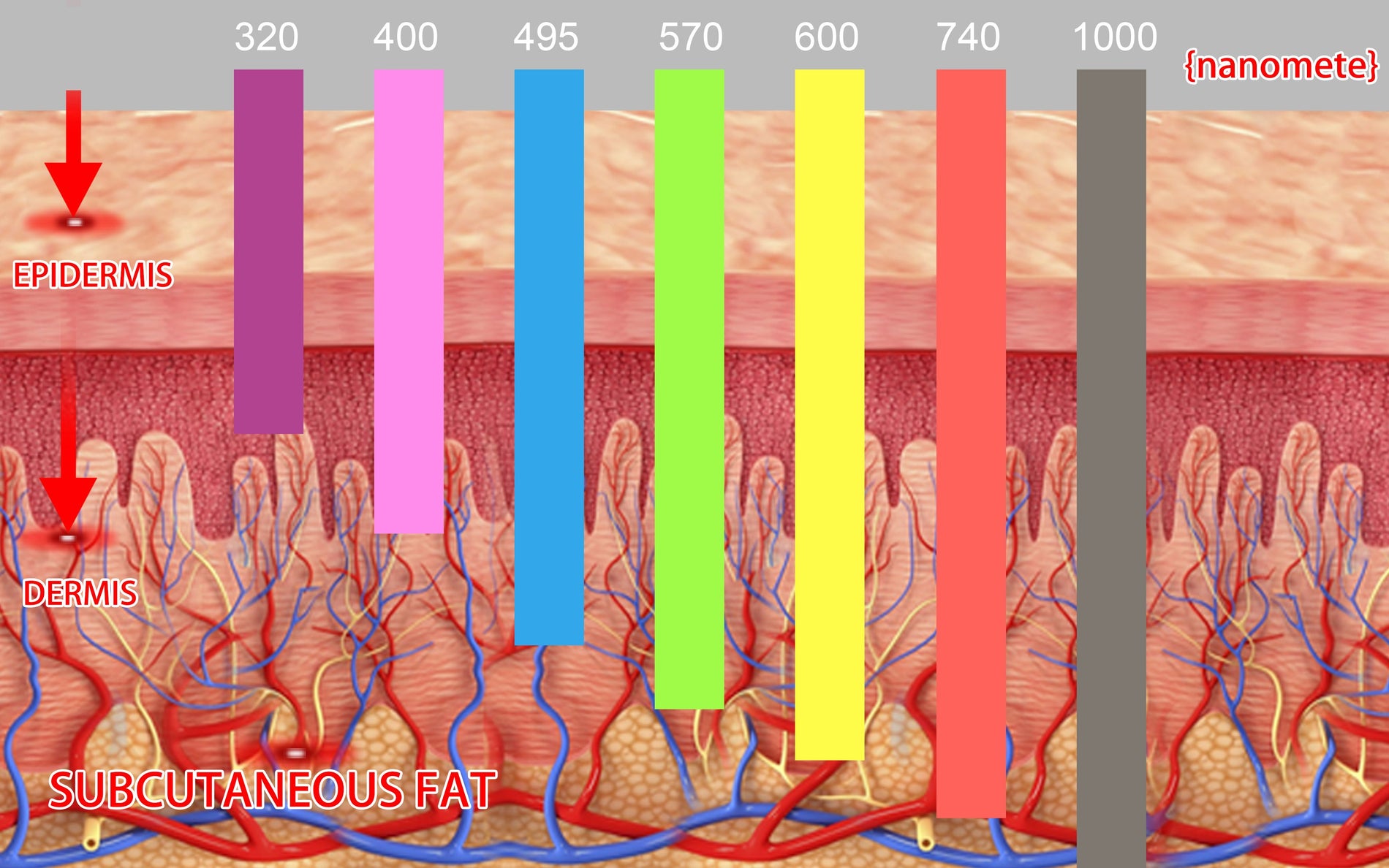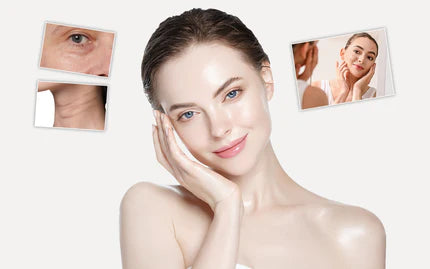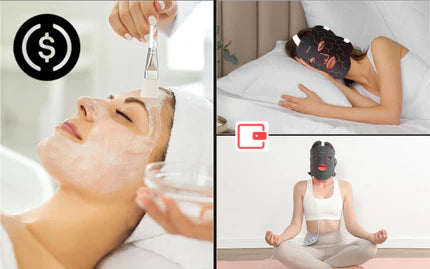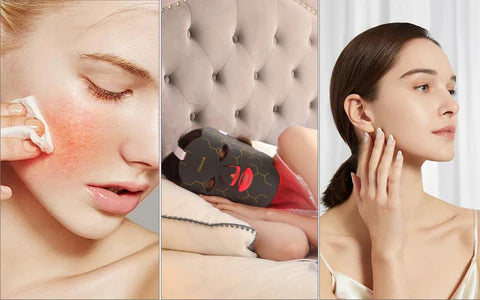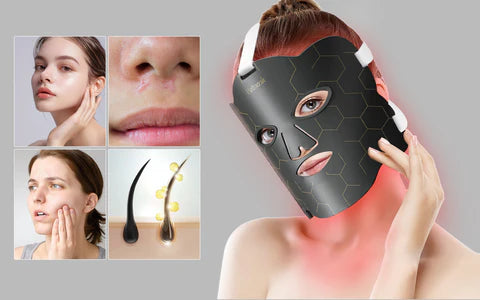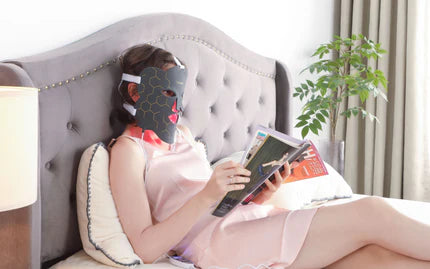Light therapy is a straightforward treatment that uses different colors of light to help heal and improve skin. Each color has its own role-red light can help reduce wrinkles, blue light might clear up acne, and there are more types with other uses. This article explains how each kind of light helps with certain health issues. We'll also cover safety tips, like how long to use red light therapy masks, so you can use these treatments without worry. Whether it's for your skin, pain relief, or even improving your mood, light therapy is becoming an easy-to-use solution for many health concerns.

Different Wavelengths of Light Therapy
Light therapy harnesses specific wavelengths of light to target a variety of health issues, with each wavelength offering distinct benefits:
- Red Light Therapy (630 to 700 nanometers): This range helps boost skin health by increasing collagen production, which can reduce wrinkles and fine lines. It's also used for wound healing and pain relief, as it enhances cell regeneration and calms inflammation. Devices like red light masks are popular for at-home skincare routines.
- Blue Light Therapy (400 to 495 nanometers): Known for its antibacterial properties, blue light is effective against acne. It works by killing the bacteria that cause breakouts and reducing oil production in the skin. Blue light therapy is also used to treat mood disorders like seasonal affective disorder (SAD) because it can help regulate circadian rhythms.
- Near-Infrared Light Therapy (700 to 1000 nanometers): Invisible to the naked eye, this therapy penetrates deeper into the body, aiding in muscle recovery, chronic pain management, and even brain health. Near-infrared light promotes healing and reduces pain and inflammation deep within tissues.
- Ultraviolet (UV) Light Therapy (100 to 400 nanometers): UV light, especially UVB, is employed to treat skin conditions such as psoriasis, eczema, and vitiligo by influencing the skin's immune response. While beneficial, it requires careful monitoring due to the risks associated with UV exposure, such as skin aging and an increased chance of skin cancer.
- Yellow Light Therapy (570 to 620 nanometers): Gentle on the skin, yellow light targets the top layers to stimulate repair and address conditions like redness, rosacea, and sun damage. It's particularly suited for sensitive skin and helps improve the skin's overall tone and texture.
Red Light Therapy
What is Red Light Therapy?
Red light therapy, also known as low-level laser therapy or photobiomodulation, employs a range of red and near-infrared wavelengths, typically from 630 to 700 nanometers. The process works by emitting photons that are absorbed by mitochondria, the energy powerhouses within cells. This absorption can stimulate the mitochondria to operate more efficiently, potentially leading to enhanced cell regeneration and repair. As a result, the body may produce more collagen, elastin, and other proteins that are critical for maintaining healthy skin structure and healing.

What Can Red Light Therapy Do for You?
The applications of red light therapy are diverse, ranging from cosmetic to medical. Here are some common uses:
- Skin Health: Often used in dermatology, red light therapy can help reduce signs of aging, such as wrinkles and fine lines, by enhancing collagen production. It can also help reduce inflammation and redness associated with acne or rosacea.
- Wound Healing: Due to its ability to promote cell repair and regeneration, red light therapy can expedite the healing process of wounds, cuts, and scars.
- Pain Relief: Red light has been shown to reduce pain and inflammation in conditions like arthritis, muscle soreness, and other chronic pains by stimulating blood circulation and reducing inflammation.
- Hair Growth: Some studies suggest that red light therapy could encourage hair growth by increasing blood flow to the scalp and stimulating hair follicle cells.
- Mood and Sleep: Exposure to red light may improve sleep quality by helping regulate circadian rhythms, and has been explored as a treatment for seasonal affective disorder (SAD).
Staying Safe with Red Light Therapy
When using red light therapy, including treatments with red light therapy masks, it's crucial to prioritize safety. Start by speaking with a healthcare provider, especially if you have skin sensitivities or are on medication that makes your skin light-sensitive. Always adhere to the recommended usage guidelines from the mask's manufacturer, which include session duration and frequency to avoid irritating your skin. Keep an eye on how your skin responds, and if any irritation occurs, stop using the mask immediately and consult a professional. Gradually increase treatment time as your skin gets used to the light, and follow up with a gentle moisturizer and sun protection after use.
Blue Light Therapy
What is Blue Light Therapy?
Blue light therapy is a procedure where the blue portion of the visible light spectrum is used, falling within the range of wavelength from 400 to 495 nanometers and having energetic properties. It basically works by simply focusing this special light onto the skin, where it stimulates a variety of reactions. These reactions come in handy in the treatment of various skin conditions, especially since the blue light acts in unison with other chemicals in the skin to destroy bacteria responsible for acne, thereby regulating oil production.

What Are the Common Uses of Blue Light Therapy?
Blue light is widely recognized for several applications in both medical and cosmetic fields:
- Acne Treatment: One of the most common uses of blue light therapy is in treating acne. The blue wavelengths are known to kill the bacteria Propionibacterium acnes that causes acne, which works very well for the treatment of reducing active breakouts.
- Skin Disorders: Conditions like psoriasis and eczema may also be kept under control with blue light therapy due to its anti-inflammatory effects.
- Mood Disorders: Because of its impact on circadian rhythms, blue light therapy is sometimes used to treat mood disorders, including seasonal affective disorder (SAD), by mimicking natural daylight.
- Jaundice Treatment: A specific application in babies is treating jaundice because blue light therapy assists in the breaking down of bilirubin that causes yellowing of the skin.
Staying Safe with Blue Light Therapy
Blue light therapy can be helpful, but it's important to use it safely. Wear eye protection to protect your eyes from damage and not for too long a duration so as not to incur damage to your retina. The time factor for each session should be regulated by some healthcare professional who would brief you about the length of the session to be had with respect to the condition you are suffering from. If you happen to use blue light devices at home, be certain about their safety. Keep in mind that overexposure to very bright visible light may dry or irritate your skin.
Near-Infrared Light Therapy
What is Near-Infrared Light Therapy?
Near-infrared light therapy uses wavelengths from 700 to 1000 nanometers, invisible to the naked eye, to penetrate deeper into the body's tissues than red light therapy. This helps deliver energy deep into the muscle, nerve, and bone cells, promoting healing, reducing inflammation, and easing pain. It is believed that this therapy releases nitric oxide, which dilates the blood vessels, thus improving blood flow and delivery of oxygen, relaxing muscles, and increasing the energy use of the cells.
What Can Near-Infrared Light Therapy Do for You?
The applications of near-infrared light therapy are extensive due to its ability to reach deeper structures within the body:
- Muscle Recovery: NIR therapy is beneficial to athletes and those with muscle injuries by increasing blood flow to the affected areas, breaking down lactic acid, and increasing recovery time to lessen muscle fatigue.
- Chronic Pain Management: When one has chronic pain-such as from conditions like fibromyalgia or osteoarthritis-the use of NIR may alleviate that by reducing inflammation and stimulating the release of endorphins.
- Brain Health: There is growing research that NIR might offer neuroprotection and hence help in treating brain disorders such as traumatic brain injury, stroke, or Alzheimer's disease.
- Wound Healing: NIR therapy can facilitate wound healing by promoting cellular repair and regeneration, making it valuable for post-surgical healing or diabetic ulcers.
- Skin Rejuvenation: Even though it is not as much applied to skin health as red light, near-infrared will still contribute a share to lessening fine lines, wrinkles, and general skin tone by stimulating collagen production deeper within the skin.
Precautions and Usage
Before starting near-infrared (NIR) light therapy, it's crucial to take certain safety steps: Wear protective goggles to shield your eyes from the strong light, and always follow the manufacturer's instructions on how long and how often to use the device to prevent skin damage. Only use NIR devices that are certified for home use; professional-grade equipment is more powerful and should only be operated by trained professionals. Lastly, for safe and effective treatment, consult with a healthcare provider for guidance tailored to your individual health needs.
Ultraviolet (UV) Light Therapy
What is UV Light Therapy?
UV light therapy, or phototherapy, uses the ultraviolet part of light (between 100 to 400 nanometers) to treat various skin conditions. It mainly uses UVA and UVB rays, avoiding the more harmful UVC rays. The treatment involves carefully measured doses of UV light on the skin, leading to changes like increased vitamin D production from UVB rays, crucial for healthy bones and a strong immune system. This exposure can also alter the DNA in skin cells and affect their immune response, which can be beneficial in treating certain skin disorders.
What Can UV Light Therapy Do for You?
Here are some of the key medical applications for UV light therapy:
- Skin Conditions: UVB phototherapy is commonly used to treat skin disorders such as psoriasis, eczema, and vitiligo. It can reduce itching and inflammation, slow the overproduction of skin cells, and in the case of vitiligo, sometimes stimulate melanin production.
- Mood Disorders: Exposure to UVA light, particularly in combination with a medication that increases skin sensitivity to light, can help improve symptoms of certain mood disorders, including seasonal affective disorder (SAD).
- Vitamin D Deficiency: UVB light exposure is an effective way to increase vitamin D levels in individuals who may have a deficiency due to lack of sunlight exposure or dietary intake.
Precautions and Considerations
When using UV light therapy, it's important to be careful because it can cause skin aging, eye damage, or even increase the risk of skin cancer. A doctor should always oversee its use. You'll need to wear protective glasses during sessions, and any skin not being treated should be covered. Also, after treatment, stay out of the sun to avoid burns, as your skin will be more sensitive. UV therapy is only used when it's clearly needed and when safety steps are carefully followed.
Yellow Light Therapy
What is Yellow Light Therapy?
Yellow light therapy, also known as amber light therapy, includes a warm, gentle range of light between 570 and 620 nanometers. This is visible light, which radiates a soft glow, only affecting the uppermost layers of the skin. It is fully absorbed into the outermost layer of the skin and triggers repair and rejuvenation without causing damage or irritation; hence, very suitable for sensitive skin. It will help with surface-level skin concerns and supposedly have a calming effect.
What Can Yellow Light Therapy Do for You?
Yellow light therapy is utilized for a variety of skin-related conditions and general wellness purposes:
- Skin Rejuvenation: Due to the light's stimulation action on rejuvenation, yellow light is able to improve skin texture and tone, hence making the skin look healthier.
- Redness and Rosacea: Yellow light therapy is known to be particularly efficient at reducing redness, therefore it's indicated in patients who have rosacea or other pathologies associated with inflamed and irritated skin.
- Wound Healing: It may aid in the skin's healing process, helping to mend damaged tissues and reduce the visibility of scars.
- Sun Damage Repair: This kind of treatment will benefit anyone who wants to undo or improve the superficial skin damage resulting from excessive sun exposure.
Safety and Usage Practices
Yellow light therapy is safe for all skin types. It is not dangerous like the UV light. Eye protection is not needed in most cases, but you should never look directly at the light. These treatments are fast, and they can also take 10-30 minutes. A skincare professional can also tell you how often you do them. You can even do it at home using devices as long as they follow the safety guidelines given and follow carefully the directions. However, consulting your doctor or dermatologist should be first considered before starting a session especially if you have skin problems.
Final Thoughts
Light therapy uses different colors of light to promote healing and improve your body's well-being. You've got red light to smooth out skin, blue light to fight acne, and deep-penetrating near-infrared for muscle pain. It's super easy to use, too-just like flipping on a light while you chill with a book or have your coffee. But remember, don't overdo it to avoid irritating your skin. These helpful light tools are getting cheaper and smarter, so they might just become as common as smartphones, giving everyone a chance to look and feel better without much fuss.
